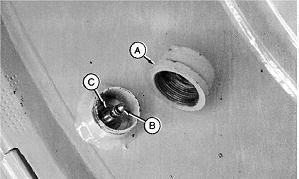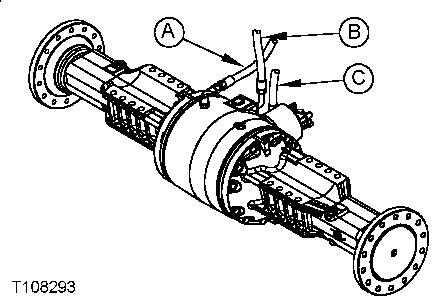644J (SN. before 611231) and 724J (SN. before 611218) Loader Repair
REPAIR TECHNICAL MANUAL
4WD Loaders models 644J (SN. -611231), 724J (SN. -611218)
TM2076 30 JUL 09 (ENGLISH)
For complete service information also see:

644J (SN. -611231) and 724J (SN. -611218) Loader Diagnostic
PowerTech 8.1 L Diesel Engines Base Engine
Alternators and Starting Motors
PowerTech E 4.5 and 6.8L Diesel Engines Level 16 Electronic Fuel System With Denso HPCR
TMIV1200 - 1400 Series Inboard Planetary Axles
PowerTech 4045, 6068 Diesel Engine Level 14 Electronic Fuel System with the Denso High Pressure Common Rail (HPCR) Level 14 ECU
Super Caddy Oil Cleanup Procedure
PowerTech 8.1L Diesel Engines Level 9 Electronic Fuel System With Denso High Pressure Common Rail
TeamMate III 1000, 1200, and 1400 Series Inboard Panetary Axles
120 Series Hydraulic Cylinders
185 Series Hydraulic Cylinders
120 Series Hydraulic Cylinders
PowerTech 4.5L & 6.8L Diesel Engines Tier 1/Stage I, Tier 2/Stage II, Tier 3/Stage IIIA, Tier 3/Stage IIA Tier 3/Stage III, (Base Engine)
TM2075

CTM86
CTM77
CTM502
CTM442

CTM320
CTM310
CTM255
CTM150
CTM120519
CTM114919
CTM114319
CTM104 John Deere Construction and Forestry Pinted by Belgreen
FOREWORD
Table of contents
TECHNICAL INFORMATION FEEDBACK FORM
Section 00 - GENERAL INFORMATION
Group 0001 - Safety Information
Section 01 - WHEELS
Group 0110 - Powered Wheels And Fasteners
Section 02 - AXLES AND SUSPENSION SYSTEMS
Group 0200 - Removal And Installation
Group 0225 - Input Drive Shafts And U-Joints
Group 0250 - Axle Shaft, Bearings, And Reduction Gears
Group 0260 - Hydraulic System
Section 03 - TRANSMISSION
Group 0300 - Removal And Installation
Group 0350 - Gears, Shafts, Bearings And Power Shift Clutch
Group 0360 - Hydraulic System
Section 04 - ENGINE
Group 0400 - Removal And Installation
Section 05 - ENGINE AUXILIARY SYSTEMS
Group 0505 - Cold Weather Starting Aids
Group 0510 - Cooling System
Group 0515 - Speed Controls
Group 0520 - Intake System
Group 0530 - External Exhaust System
Group 0560 - External Fuel Supply Systems
Section 07 - DAMPENER DRIVE
Group 0752 - Elements
Section 09 - STEERING SYSTEM
Group 0960 - Hydraulic System
Section 10 - SERVICE BRAKES
Group 1011 - Active Elements
Group 1060 - Hydraulic System
Section 11 - PARK BRAKE
Group 1111 - Active Elements
Group 1160 - Hydraulic System
Section 17 - FRAME OR SUPPORTING STRUCTURE
Group 1740 - Frame Installation
Group 1746 - Frame Bottom Guards
Group 1749 - Chassis Weights
Section 18 - OPERATOR’S STATION
Group 1800 - Removal And Installation
Group 1810 - Operator Enclosure
Group 1830 - Heating And Air Conditioning
Section 19 - SHEET METAL AND STYLING
Group 1910 - Hood Or Engine Enclosure
Group 1921 - Grille And Grille Housing
Section 31 - LOADER
Group 3102 - Bucket
Group 3140 - Frames
Group 3160 - Hydraulic System
Section 9900 - DEALER FABRICATED TOOLS
Group 0099 - Dealer Fabricated Tools
TM2076-REPAIR TECHNICAL MANUAL (g) by Belgreen v2.5 <- Go to Global Table of contents TM2076-REPAIR TECHNICAL MANUAL

<- Go to Global Table of contents TM2076-REPAIR TECHNICAL MANUAL
Foreword
This manual is written for an experienced technician. Essential tools required in performing certain service work are identified in this manual and are recommended for use.
Live with safety: Read the safety messages in the introduction of this manual and the cautions presented throughout the text of the manual.

CAUTION:
This is the safety-alert symbol. When you see this symbol on the machine or in this manual, be alert to the potential for personal injury.

Technical manuals are divided in two parts: repair and operation and tests. Repair sections tell how to repair the components Operation and tests sections help you identify the majority of routine failures quickly.
Information is organized in groups for the various components requiring service instruction. At the beginning of each group are summary listings of all applicable essential tools, service equipment and tools, other materials needed to do the job, service parts kits, specifications, wear tolerances, and torque values.
Technical Manuals are concise guides for specific machines. They are on-the-job guides containing only the vital information needed for diagnosis, analysis, testing, and repair.
Fundamental service information is available from other sources covering basic theory of operation, fundamentals of troubleshooting, general maintenance, and basic type of failures and their causes.
TM2076-REPAIR TECHNICAL MANUAL (g) by Belgreen v2.5 <- Go to Global Table of contents TM2076-REPAIR TECHNICAL MANUAL
Technical Information Feedback Form
We need your help to continually improve our technical publications. Please copy this page and FAX or mail your comments, ideas and improvements.
Installation Instruction Fax
SEND TO: John Deere Dubuque Works
18600 South John Deere Road
Attn: Publications, Dept. 324 Dubuque, IA 52004-0538 USA
FAX NUMBER:
Publication Number:
Page Number:
Ideas, Comments:
1-563-589-5800 (USA)
Name: Phone:
Email Address:
THANK YOU!
GENERAL INFORMATION (g) by Belgreen v2.0 Section 00 page 1 <- Go to Section TOC TM2076-REPAIR TECHNICAL MANUAL
Section 00 - GENERAL INFORMATION
TM2076-REPAIR TECHNICAL MANUAL (g) by Belgreen v2.5 <- Go to Global Table of contents TM2076-REPAIR TECHNICAL MANUAL
Table of contents Group 0001 - Safety Information........................................................................................................................ 1 Recognize Safety Information 1 Follow Safety Instructions Operate Only If Qualified . ......................................................................................... 1 . .......................................................................................... 1 Wear Protective Equipment .......................................................................................... 3 Avoid Unauthorized Machine Modifications......................................................................... 3 Add Cab Guarding For Special Uses................................................................................. 3 Inspect Machine ....................................................................................................... 4 Stay Clear of Moving Parts ........................................................................................... 4 Avoid High-Pressure Oils Beware of Exhaust Fumes . .......................................................................................... 5 .......................................................................................... 5 Prevent Fires ........................................................................................................... 6 Prevent Battery Explosions ........................................................................................... 7 Handle Chemical Products Safely 7 Dispose of Waste Properly ........................................................................................... 7 Prepare for Emergencies............................................................................................... 8 Use Steps and Handholds Correctly ................................................................................ 8 Start Only From Operator′s Seat..................................................................................... 8 Use and Maintain Seat Belt .......................................................................................... 9 Prevent Unintended Machine Movement 9 Avoid Work Site Hazards.............................................................................................. 9 Use Special Care When Operating Loader ........................................................................11 Keep Riders Off Machine Avoid Backover Accidents . .........................................................................................11 .........................................................................................12 Avoid Machine Tip Over..............................................................................................12 Operating on Slopes..................................................................................................13 Operating or Traveling On Public Roads ...........................................................................13 Inspect and Maintain ROPS ..........................................................................................14 Add and Operate Attachments Safely Park And Prepare For Service Safely ...........................................................................14 . ...........................................................................14 Service Cooling System Safely......................................................................................15 Remove Paint Before Welding or Heating.........................................................................15 Make Welding Repairs Safely .......................................................................................16 Drive Metal Pins Safely ..............................................................................................16
Group 0001 - Safety Information
Recognize Safety Information
Safety Alert Symbols
Safety Alert Symbols
This is the safety alert symbol. When you see this symbol on your machine or in this manual, be alert for the potential of personal injury.

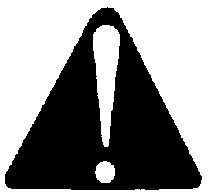
Follow the precautions and safe operating practices highlighted by this symbol.
A signal word DANGER, WARNING, or CAUTION is used with the safety alert symbol. DANGER identifies the most serious hazards.

On your machine, DANGER signs are red in color, WARNING signs are orange, and CAUTION signs are yellow. DANGER and WARNING signs are located near specific hazards. General precautions are on CAUTION labels.
Follow Safety Instructions
Follow Safety Instructions
Read the safety messages in this manual and on the machine. Follow these warnings and instructions carefully. Review them frequently. Keep safety signs in good condition. Replace missing or damaged safety signs. Be sure new equipment components and repair parts include the current safety signs. Replacement safety signs are available from your John Deere dealer.
Be sure all operators of this machine understand every safety message. Replace operator′s manual and safety labels immediately if missing or damaged
Section 00 - GENERAL INFORMATION Group 0001: Safety Information Section 00 page 1 <- Go to Section TOC TM2076-REPAIR TECHNICAL MANUAL
Operate Only If Qualified
Do not operate this machine unless you have read the operator′s manual carefully and you have been qualified by supervised training and instruction.
Familiarize yourself with the job site and your surroundings before operating. Try all controls and machine functions with the machine in an open area before starting to work.
Know and observe all safety rules that may apply to your work situation and your work site.
Section 00 - GENERAL INFORMATION Group 0001: Safety Information Section 00 page 10 <- Go to Section TOC TM2076-REPAIR TECHNICAL MANUAL
Protective Equipment
Guard against injury from flying pieces of metal or debris; wear goggles or safety glasses. Wear close fitting clothing and safety equipment appropriate to the job.

Prolonged exposure to loud noise can cause impairment or loss of hearing. Wear suitable hearing protection such as earmuffs or earplugs to protect against objectionable or uncomfortable loud noises.
Avoid Unauthorized Machine Modifications
Modifications of this machine, or addition of unapproved products or attachments, may affect machine stability or reliability, and may create a hazard for the operator or others near the machine. The installer of any modification which may affect the electronic controls of this machine is responsible for establishing that the modification does not adversely affect the machine or its performance.
Always contact an authorized dealer before making machine modifications that change the intended use, weight or balance of the machine, or that alter machine controls, performance or reliability.
Add Cab Guarding For Special Uses
Section 00 - GENERAL INFORMATION Group 0001: Safety Information Section 00 page 3 <- Go to Section TOC TM2076-REPAIR TECHNICAL MANUAL
Protective Equipment
Wear
Cab Guarding
Special work situations or machine attachments may create an environment with falling or flying objects. Loading logs, using fork attachments, or operating in waste management applications requires special work tools. Added cab guarding to protect the operator may also be required.
Use load-clamping grapples to keep bulky loads from falling and add special screens or guarding when objects may be directed toward the cab. Contact your authorized John Deere dealer for information on devices intended to protect the operator from falling or flying objects in special work situations.

Inspect Machine
Inspect Machine
Inspect machine carefully each day by walking around it before starting. Keep all guards and shields in good condition and properly installed. Fix damage and replace worn or broken parts immediately. Pay special attention to hydraulic hoses and electrical wiring.
Stay Clear of Moving Parts

Section 00 - GENERAL INFORMATION Group 0001: Safety Information Section 00 page 4 <- Go to Section TOC TM2076-REPAIR TECHNICAL MANUAL
Stay
Clear Of Moving Parts
Entanglements in moving parts can cause serious injury. Stop engine before examining, adjusting or maintaining any part of machine with moving parts. Keep guards and shields in place. Replace any guard or shield that has been removed for access as soon as service or repair is complete.

Avoid High-Pressure Oils
Avoid High Pressure Oils
Avoid High-Pressure Oils
This machine uses a high-pressure hydraulic system. Escaping oil under pressure can penetrate the skin causing serious injury. Never search for leaks with your hands. Protect hands. Use a piece of cardboard to find location of escaping oil. Stop engine and relieve pressure before disconnecting lines or working on hydraulic system.
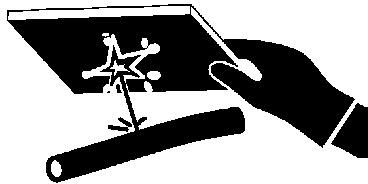
If hydraulic oil penetrates your skin, see a doctor immediately. Injected oil must be removed surgically within hours or gangrene may result. Contact a knowledgeable medical source or the Deere & Company Medical Department in Moline, Illinois, U.S.A.

Beware of Exhaust Fumes
Section 00 - GENERAL INFORMATION Group 0001: Safety Information Section 00 page 5 <- Go to Section TOC TM2076-REPAIR TECHNICAL MANUAL
Beware Of Exhaust Fumes
Prevent asphyxiation. Engine exhaust fumes can cause sickness or death. If you must operate in an enclosed space, provide adequate ventilation. Use an exhaust pipe extension to remove the exhaust fumes or open doors and windows to bring outside air into the area.
Prevent Fires
Handle Fuel Safely
Clean Machine Regularly
Carry A Fire Extinguisher
Handle Fuel Safely: Store flammable fluids away from fire hazards. Never refuel machine while smoking or when near sparks or flame.
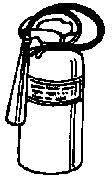
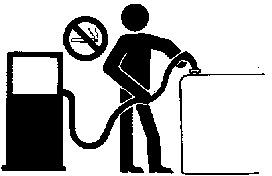
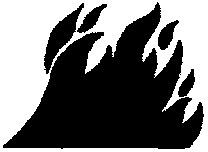

Clean Machine Regularly: Keep trash, debris, grease and oil from accumulating in engine compartment, around fuel lines, hydraulic lines, exhaust components, and electrical wiring. Never store oily rags or flammable materials inside a machine compartment.
Maintain Hoses and Wiring: Replace hydraulic hoses immediately if they begin to leak, and clean up any oil spills. Examine electrical wiring and connectors frequently for damage.
Section 00 - GENERAL INFORMATION Group 0001: Safety Information Section 00 page 6 <- Go to Section TOC TM2076-REPAIR TECHNICAL MANUAL
Keep A Fire Extinguisher Available: Always keep a multipurpose fire extinguisher on or near the machine. Know how to use extinguisher properly.
Prevent Battery Explosions
Battery Explosions
Battery gas can explode. Keep sparks, lighted matches, and open flame away from the top of battery. Never check battery charge by placing a metal object across the posts. Use a voltmeter or hydrometer. Do not charge a frozen battery; it may explode. Warm battery to 16°C (60°F).

Handle Chemical Products Safely
Handle Chemical Products Safely
Exposure to hazardous chemicals can cause serious injury. Under certain conditions, lubricants, coolants, paints and adhesives used with this machine may be hazardous.
If uncertain about safe handling or use of these chemical products, contact your authorized dealer for a Material Safety Data Sheet (MSDS) or go to internet website http://www.jdmsds.com. The MSDS describes physical and health hazards, safe use procedures, and emergency response techniques for chemical substances. Follow MSDS recommendations to handle chemical products safely.

Dispose of Waste Properly
Dispose Of Waste Properly

Section 00 - GENERAL INFORMATION Group 0001: Safety Information Section 00 page 7 <- Go to Section TOC TM2076-REPAIR TECHNICAL MANUAL
Improper disposal of waste can threaten the environment. Fuel, oils, coolants, filters and batteries used with this machine may be harmful if not disposed of properly.
Never pour waste onto the ground, down a drain, or into any water source.
Air conditioning refrigerants can damage the atmosphere. Government regulations may require using a certified service center to recover and recycle used refrigerants.
If uncertain about the safe disposal of waste, contact your local environmental or recycling center or your dealer for more information.
Prepare for Emergencies
First Aid Kit

Be prepared if an emergency occurs or a fire starts. Keep a first aid kit and fire extinguisher handy. Keep emergency numbers for doctors, ambulance service, hospital, and fire department near your telephone.
Use Steps and Handholds Correctly
Use Handholds and Steps
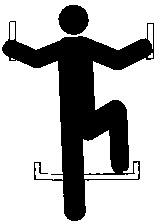
Prevent falls by facing the machine when getting on and off. Maintain 3-point contact with steps and handrails. Never use machine controls as handholds.
Use extra care when mud, snow, or moisture present slippery conditions. Keep steps clean and free of grease or oil. Never jump when exiting machine. Never mount or dismount a moving machine.
Start Only From Operator′s Seat
Section 00 - GENERAL INFORMATION Group 0001: Safety Information Section 00 page 8 <- Go to Section TOC TM2076-REPAIR TECHNICAL MANUAL
Operate Only From Operators Seat
Avoid unexpected machine movement. Start engine only while sitting in operator′s seat. Ensure all controls and working tools are in proper position for a parked machine. Never attempt to start engine from the ground. Do not attempt to start engine by shorting across the starter solenoid terminals.
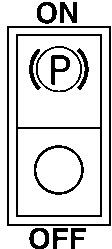
Use and Maintain Seat Belt
Use and Maintain Seat Belt
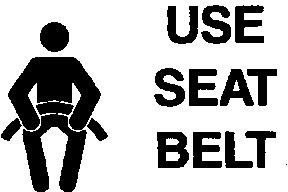

Use seat belt when operating machine . Remember to fasten seat belt when loading and unloading from trucks and during other uses.
Examine seat belt frequently. Be sure webbing is not cut or torn. Replace seat belt immediately if any part is damaged or does not function properly.
The complete seat belt assembly should be replaced every 3 years, regardless of appearance.
Prevent Unintended Machine Movement
Park Brake Switch
When coworkers are present, disable hydraulics. Lower all equipment to the ground during work interruptions. Lock transmission control in neutral, engage park brake and stop engine before allowing anyone to approach the machine.
Follow these same precautions before standing up, leaving the operator′s seat, or exiting the machine.
Section 00 - GENERAL INFORMATION Group 0001: Safety Information Section 00 page 9 <- Go to Section TOC TM2076-REPAIR TECHNICAL MANUAL
Avoid Work Site Hazards
Avoid contact with gas lines

Work Site Hazards
Work Site Hazards
Avoid contact with gas lines, buried cables and water lines. Call utility line location services to identify all underground utilities before starting work.
Prepare work site properly . Avoid operating near structures or objects that could fall onto the machine. Clear away debris that could move unexpectedly if run over.

Avoid boom or attachment contact with overhead obstacles or overhead electrical lines. Never move any part of machine or load closer than 3 m (10 ft) plus twice the line insulator length to overhead wires.

Keep bystanders clear at all times. Use barricades or a signal person to keep vehicles and pedestrians away. Use a signal person if moving machine in congested areas or where visibility is restricted. Always keep signal person in view. Coordinate hand signals before starting machine.
Operate only on solid footing with strength sufficient to support machine. Be especially alert working near embankments or excavations.
Section 00 - GENERAL INFORMATION Group 0001: Safety Information Section 00 page 10 <- Go to Section TOC TM2076-REPAIR TECHNICAL MANUAL
Avoid working under over-hanging embankments or stockpiles that could collapse on machine.
Use Special Care When Operating Loader
Never Use Loader to Lift People
Use Secial Care When Operating Loader

Never use the loader to lift people. Do not allow anyone to ride in the bucket or use the bucket as a work platform.


Operate carefully with raised loads. Raising the load reduces machine stability, especially on side slopes or an unstable surface. Drive and turn slowly with a raised load.
Ensure that objects in the bucket are secure. Do not attempt to lift or carry objects that are too big or too long to fit inside the bucket unless secured with an adequate chain or other device. Keep bystanders away from raised loads. Be careful when lifting objects. Never attempt to lift objects too heavy for your machine. Assure machine stability and hydraulic capability with a test lift before attempting other maneuvers. Use an adequate chain or sling and proper rigging techniques to attach and stabilize loads. Never lift an object above or near another person.
Keep Riders Off Machine
Section 00 - GENERAL INFORMATION Group 0001: Safety Information Section 00 page 11 <- Go to Section TOC TM2076-REPAIR TECHNICAL MANUAL
Keep Riders Off Machine
Only allow operator on machine.
Riders are subject to injury. They may fall from machine, be caught between machine parts, or be struck by foreign objects. Riders may obstruct operator’s view or impair his ability to operate machine safely.

Avoid Backover Accidents
Backover Warning

Before moving machine, be sure all persons are clear of machine path. Turn around and look directly for best visibility. Use mirrors to assist in checking all around machine. Keep windows and mirrors clean, adjusted, and in good repair. Be certain reverse warning alarm is working properly. Use a signal person when backing if view is obstructed or when in close quarters. Keep signal person in view at all times. Use prearranged hand signals to communicate.
Avoid Machine Tip Over
Use Seat Belt

Section 00 - GENERAL INFORMATION Group 0001: Safety Information Section 00 page 12 <- Go to Section TOC TM2076-REPAIR TECHNICAL MANUAL
Do Not Jump
Ensure solid footing
Use seat belt at all times.
Do not jump if the machine tips. You will be unlikely to jump clear and the machine may crush you.
Load and unload from trucks or trailers carefully. Be sure truck is wide enough and on a firm level surface. Use loading ramps and attach them properly to truck bed.
Be careful on slopes. Avoid sharp turns. Balance loads so weight is evenly distributed and load is stable. Carry tools and loads close to the ground to aid visibility and lower center of gravity. Use extra care on soft, rocky, or frozen ground.
Know the capacity of the machine. Do not overload. Be careful with heavy loads. Using oversize buckets or lifting heavy objects reduces machine stability.
Ensure solid footing. Use extra care in soft ground conditions that may not uniformly support the wheels, especially when raising the boom. Do not operate close to banks or open excavations that may cave in and cause machine to tip or fall.
Operating on Slopes
Operating on Slopes
Avoid side slope travel whenever possible. Drive up steep slope in forward and down in reverse. Select low gear speed before starting down slope. The grade of the slope will be limited by ground condition and load being handled.
Use service brakes to control speed. Sudden brake application with a loaded bucket on downhill side could cause machine to tip forward.

Operating or Traveling On Public Roads

Section 00 - GENERAL INFORMATION Group 0001: Safety Information Section 00 page 13 <- Go to Section TOC TM2076-REPAIR TECHNICAL MANUAL
Operating or Traveling On Public Roads
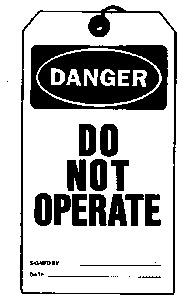
Machines that work near vehicle traffic or travel slower than normal highway speeds must have proper lighting and markings to assure they are visible to other drivers. Install additional lights, beacons, slow moving vehicle (SMV) emblems, or other devices and use as required to make the machine visible and identify it as a work machine. Check state and local regulations to assure compliance. Keep these devices clean and in working condition.
Inspect and Maintain ROPS
A damaged roll-over protective structure (ROPS) should be replaced, not reused. The protection offered by ROPS will be impaired if ROPS is subjected to structural damage, is involved in an overturn incident, or is in any way altered by welding, bending, drilling, or cutting.
If ROPS was loosened or removed for any reason, inspect it carefully before operating the machine again.
To maintain the ROPS:
Replace missing hardware using correct grade hardware. Check hardware torque.
Check isolation mounts for damage, looseness or wear; replace them if necessary. Check ROPS for cracks or physical damage.
Add and Operate Attachments Safely
Always verify compatibility of attachments by contacting your authorized dealer. Adding unapproved attachments may affect machine stability or reliability, and may create a hazard for others near the machine.
Ensure that a qualified person is involved in attachment installation. Add guards to machine if operator protection is required or recommended. Verify that all connections are secure and attachment responds properly to controls. Carefully read attachment manual and follow all instructions and warnings. In an area free of bystanders and obstructions, carefully operate attachment to learn its characteristics and range of motion.
Park And Prepare For Service Safely

Section 00 - GENERAL INFORMATION Group 0001: Safety Information Section 00 page 14 <- Go to Section TOC TM2076-REPAIR TECHNICAL MANUAL
Do Not Operate Tag
Support Machine Properly
Warn others of service work. Always park and prepare your machine for service or repair properly.
Park machine on a level surface and lower equipment to the ground. Engage park brake.
Stop engine and remove key.
Install frame locking bar.
Attach a “Do Not Operate” tag in an obvious place in the operator′s station.
Securely support machine or attachment before working under it.
Do not support machine with boom, bucket, or other hydraulically actuated equipment. Do not support machine with cinder blocks or wooden pieces that may crumble or crush. Do not support machine with a single jack or other devices that may slip out of place


Understand service procedures before beginning repairs. Keep service area clean and dry. Use two people whenever the engine must be running for service work.
Service Cooling System Safely
Cooling System
Explosive release of fluids from pressurized cooling system can cause serious burns. Shut off engine. Only remove filler cap when cool enough to touch with bare hands. Slowly loosen cap to first stop to relieve pressure before removing completely.
Remove Paint Before Welding or Heating
Section 00 - GENERAL INFORMATION Group 0001: Safety Information Section 00 page 15 <- Go to Section TOC TM2076-REPAIR TECHNICAL MANUAL
Toxic Fumes
Avoid potentially toxic fumes and dust.
Hazardous fumes can be generated when paint is heated by welding, soldering, or using a torch.
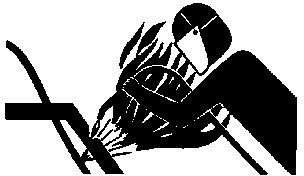
Remove paint before heating:
Remove paint a minimum of 100 mm (4 in.) from area to be affected by heating. If paint cannot be removed, wear an approved respirator before heating or welding.
If you sand or grind paint, avoid breathing the dust. Wear an approved respirator.

If you use solvent or paint stripper, remove stripper with soap and water before welding. Remove solvent or paint stripper containers and other flammable material from area. Allow fumes to disperse at least 15 minutes before welding or heating.
Do not use a chlorinated solvent in areas where welding will take place. Do all work in an area that is well ventilated to carry toxic fumes and dust away.
Dispose of paint and solvent properly.
Make Welding Repairs Safely
Avoid Heating Near Pressurized Fluid Lines
IMPORTANT:
Disable electrical power before welding. Turn off main battery switch or disconnect positive battery cable. Separate harness connectors to engine and vehicle microprocessors.
Avoid welding or heating near pressurized fluid lines. Flammable spray may result and cause severe burns if pressurized lines fail as a result of heating. Do not let heat go beyond work area to nearby pressurized lines.
Remove paint properly. Do not inhale paint dust or fumes. Use a qualified welding technician for structural repairs. Make sure there is good ventilation. Wear eye protection and protective equipment when welding.
Drive Metal Pins Safely
Section 00 - GENERAL INFORMATION Group 0001: Safety Information Section 00 page 16 <- Go to Section TOC TM2076-REPAIR TECHNICAL MANUAL
Hardened Metal Parts
Always wear protective goggles or safety glasses and other protective equipment before striking hardened parts. Hammering hardened metal parts such as pins and bucket teeth may dislodge chips at high velocity. Use a soft hammer or a brass bar between hammer and object to prevent chipping.
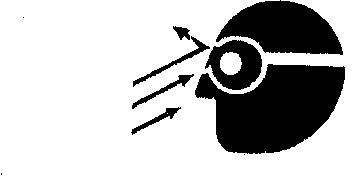
Section 01 page 17 <- Go to Section TOC TM2076-REPAIR TECHNICAL MANUAL
WHEELS (g) by Belgreen v2.0
<- Go to Global Table of contents TM2076-REPAIR TECHNICAL MANUAL Section 01 - WHEELS Table of contents Group 0110 - Powered Wheels And Fasteners ................................................................................................ 1 Wheel Remove and Install 1 Tire Remove and Install .............................................................................................. 2 TM2076-REPAIR TECHNICAL MANUAL (g) by Belgreen v2.5
Group 0110 - Powered Wheels And Fasteners

Wheel Remove and Install
[1] - Raise machine and place 10-ton shop stand under axle.
10-Ton Shop Stand
Used to support unit while removing and installing wheels.
[2] -
CAUTION: Use a lifting device for heavy components.

Place wheel lift under wheel. Fasten safety chain around upper part of tire.
Wheel Lift
Used to remove and install wheels.
[3] -
LEGEND: A Cap Screw (14 used)
Wheel Cap Screws
Remove cap screws (A) to remove wheel.
[4] - Clean mounting surface on wheel and axle flange. Install wheel.
Tighten cap screws.
Item Remove and Install Wheel
Section 01 - WHEELS Group 0110: Powered Wheels And Fasteners Section 01 page 1 <- Go to Section TOC TM2076-REPAIR TECHNICAL MANUAL
Measurement Specification Wheel Retainer Cap Screws Dry Torque 620 N˙m 460 lb-ft












































